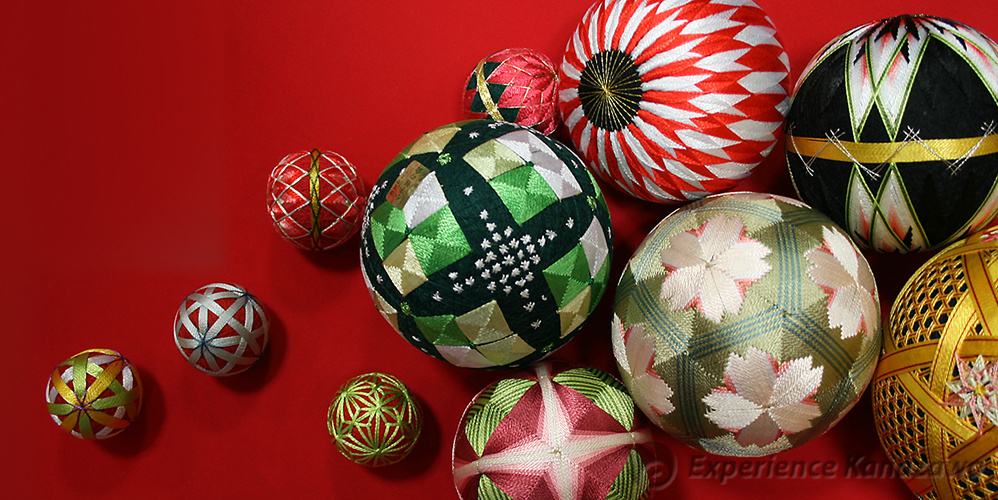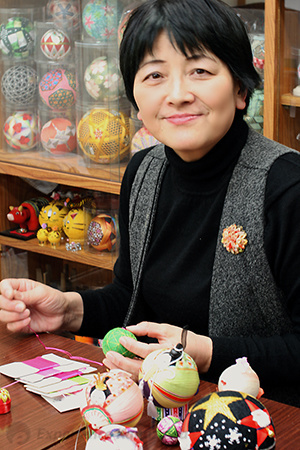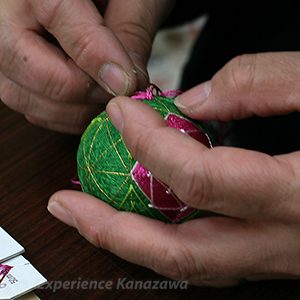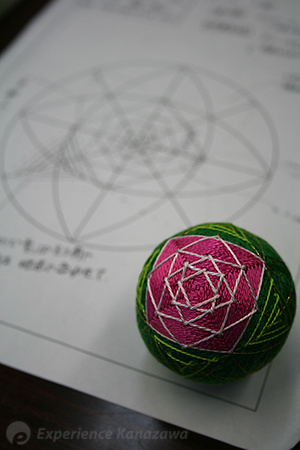Kaga Temari

Kanazawa Tradition: Mother Makes a Handball for Her Daughter's Wedding.
Once upon a time, girls made their own handballs to play with. More once upon a time, boys played football with a ball made of deerskin. These are the history of traditional ballgames. In the Muromachi Period (app. 1336 - 1573), Temari handballs with expensive silk threads were popular, but only for noble girls. During the Edo Period (1603 – 1868), it finally spread to ordinary people with the progress of the cotton industry. Girls must have competed with one another in trying to make new and beautiful designs. Look at the pictures! Now only skillful masters can create such designs. They take your breath away, huh? In Kanazawa we have an old custom that a mother sends a handmade Temari to her daughter as an amulet for her wedding.
Oh, speaking of which, I heard an interesting story. I was wondering if those traditional handballs could be bounced like a rubber one, Then, I learned that the secret is the wadding. Usually Temari handballs with normal cotton are not so springy, but those with osumunda japonica cotton are more bounceable. Amazing, huh?

Kaga Temari Master Takako Koide
Good sound, good luck!
I visited a Kaga Temari class at the specialty shop Mari-Ya, to see one the master, Takako Koide. Her mother-in-law is the great master who taught her how to make Kaga Temari. Now she has made handballs for more than 30 years.
She teaches people how to make them twice a week. It’s open from 10:00 to 16:00, and the students can stay there for one hour, half a day, or the whole day, whenever you have time.
“Of course, our teacher did! Look at all those Temari on the shelf! She’ll show you them later!” Whoa! The showcase was packed with colorful handballs made by the master. From classic handballs with Japanese patterns to Christmas ornaments with Santa Claus! Some are more than just handballs, such as the stuffed ornaments representing the twelve zodiac signs, or music boxes.


Usually Temari have tiny bells inside, so you can enjoy the lovely sound when it’s being rolled around. She says with a smile, “It’s said that if you can hear a beautiful sound from the inside, it’s a sign that something good will happen.” Her family owns this specialty shop, and her daughter is also teaching others how to make thimble. It seems that all is going well with her life, and that must be because she can hear a beautiful sound every day!
By SHIZUO
Published: February 8, 2011
Kanazawa Area
Kenrokuenn Garden
Following Matsuo Bashô’s steps in Ishikawa - 1/6 [Introduction]
Following Matsuo Bashô’s steps in Ishikawa - 2/6 [Kanazawa]
Noto Area
Mitsukejima Island
Kaga Area
Following Matsuo Bashô’s steps in Ishikawa - 3/6 [Komatsu City]
Following Matsuo Bashô’s steps in Ishikawa - 4/6 [Natadera Temple]
Following Matsuo Bashô’s steps in Ishikawa - 5/6 [Yamanaka Onsen Town]
Following Matsuo Bashô’s steps in Ishikawa - 6/6 [Daishoji District]
Rosanjin in Yamashiro Onsen Town
Stroll Kanazawa in Rental Kimono - 1/2 [Kimono Rental]
Stroll Kanazawa in Rental Kimono - 2/2 [Kimono Stroll]
January
Enyukai: Geisha Party
February
Setsubun-Sai Festival
AUGUST
Issaki Hoh-Toh Matsuri
November
Enyukai: Geisha Party
